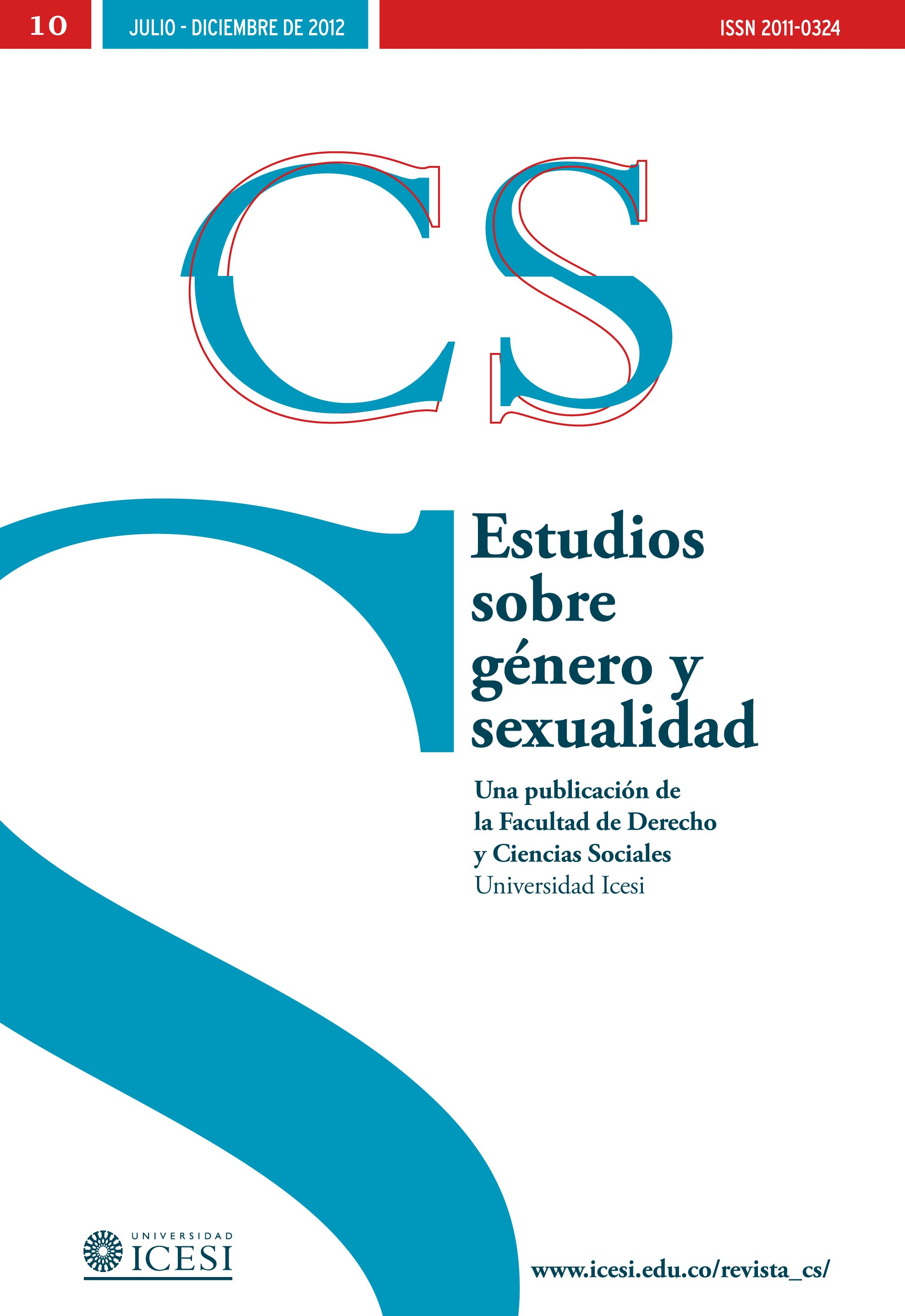Performativity and Hate Speech: Expressions of Male Homosexuality in Cali
DOI:
https://doi.org/10.18046/recs.i10.1359Keywords:
Hate Speech, Homosexuality, Performative acts, Deconstruction, AllegoryAbstract
This article analyzes the speech of a group of self-identified homosexual men in Cali inwhich they refer to the visibilization of homosexuality and its consequences. Distancingitself from the explanation of such speech as “internal homophobia” or as “endo-discrimiation,”the current study instead utilizes Judith Butler’s concept of performativityin three categories of analysis: allegory, implicit and explicit norms, and desire/aversion.Based on this analysis, this hate speech can be read as a succession of performative actsthat constitute an idealized subject while simultaneously reaffirming a desired yet threatenedmasculinity. These performative acts not only allow them to defend themselves againsta perceived persecution for a sexual abjection that threatens heteronormativity, but alsoallow for a strong component of homoerotic desire to be embedded within such speech.Downloads
References
Alarcón, A. (2008). Qué posee de 'queer' tiene la autobiografía areniana Antes que anochezca?. Neophilologus, 92 (4), 641–649.
Arenas, R. (1992). Antes que anochezca. Barcelona, España: Tusquets.
Arias de la Canal, F. (2002). Antología de la poesía homosexual y cósmica de Shakespeare. México D.F., México: Frente de Afirmación Hispanista.
Asociación Internacional de Gays y Lesbianas, ILGA. 2011. Portal online, disponible en http://ilga.org
Bourdieu, P. y Passeron, J. C. (1970). La reproducción. Elementos para una teoría del sistema de enseñanza. Madrid, España: Popular.
Butler, J. (1995). Conscience doth make us subjects of us all. Yale French Studies, 88, 1995, 6–26.
Butler, J. (2004). Precarious Life. The powers of Mourning and Violence. New York, USA: Verso.
Butler, J. (2005). Lenguaje, poder e identidad. Madrid, España: Síntesis.
Butler, J. (2005a). Giving an Account of Oneself. New York, USA: Fordham University Press.
Butler, J. (2009). Frames of War. When Life is Griefable?. New York, USA: Verso.
Butler, J. y Spivak, G. (2007). Who Sings the Nation – State?. New York, USA: Seagull.
Butler, J., Habermas, J., Taylor, C. y West, C. (2011). The Power of Religion in Public Sphere. New York, USA: Columbia University Press.
Castelar, A. (2008). 'La identidad en disputa. Una propuesta filosófica de Judith Butler', Tesis de Maestría en Filosofía, Universidad del Valle.
Castelar, A. (2010). Familia y homoparentalidad: una revisión de tema. Revista CS, (5), 45–70.
Eribon, D. (2004). Una moral de lo minoritario. Barcelona, España: Anagrama.
Fernández, F. (2004). '¿Hombres de verdad?' Estereotipo masculino, relaciones entre los géneros y ciudadanía. Foro Interno, (4), 15–43.
Foucault, M. (1975). Vigilar y castigar. El nacimiento de la prisión. México D.F., México: Siglo XXI.
Foucault, M. (1977). Historia de la sexualidad. México D.F., México: Siglo XXI.
Freud, S. (1913). Tótem y tabú. En Obras Completas. Tomo XIII. Buenos Aires, Argentina: Amorrortu.
Freud, S. (1925). La negación. En Obras Completas. Tomo XIX. Buenos Aires, Argentina: Amorrortu.
Gómez, F. (2011). La sexualidad de los angelitos. Arcadia, (69), 16–17.
Gómez, M.M. (2007). Violencia, homofobia y psicoanálisis: entre lo secreto y lo público. RES, (28), 72–85.
Granados, A. (2005). 'Ser gay es de machos. Prejuicio social y comportamiento gay – Etnografía en el bar Maraka de la ciudad de Cali', Tesis en Trabajo Social, Universidad del Valle.
Kaminsky, A. (2008). Hacia un verbo queer. Revista Iberoamericana, 74 (225), 879–895.
Kimmel, M. (1994). Masculinity as Homophobia. Fear, Shame and Silence in the Construction of Gender Identity. En H. Brod y M. Kaufman (Eds.), Theorizing Masculinities. Thousand Oaks, USA: Sage Publications.
Manrique, J. (2000). Maricones eminentes: Arenas, Lorca, Puig y yo. Barcelona, España: Síntesis.
Mora, D. (2002). La teoría de las representaciones sociales de Serge Moscovici. Athenea Digital, (2). Consultado en octubre de 2010 en: http://psicologiasocial.uab.es/athenea/index.php/atheneaDigital/article/.../55/5
Moreno, C. (2009). 'Lugares de encuentro gay en Cali: bares, restaurantes y discotecas', Tesis de grado en Geografía, Universidad del Valle.
Portal MediaIte. Michel Bachman, Gay Rights and the Role of Faith in Politics. Consultado en septiembre de 2011 en: http://www.mediaite.com/online/michele–bachmann–gay–rights–and–the–role–of–faith–in–politics/
Quintero, F. (2011). 'Representaciones sociales de la masculinidad en 10 hombres homosexuales de la ciudad de Cali', Tesis de grado en Psicología, Pontificia Universidad Javeriana.
Salazar, A. (1995). 'Nictálopes al encuentro de otro que es un yo. Sociografía de los lugares para hombres gay en Cali', Trabajo de grado en Sociología, Universidad del Valle.
Sancho, A. et al. (2009). Una investigación narrativa en torno del aprendizaje de las masculinidades en la escuela. Revista mexicana de investigación educativa, 14 (43), 1155–1189.
Sierra, A. (2008). Una aproximación a la teoría queer. El debate entre la libertad y la ciudadanía. El Ateneo de La Laguna, (26). Consultado en septiembre de 2012 en: http://www.ateneodelalaguna.es/pdf/ATENEO26/aprox.pdf
Viteri, M.A., Serrano, J. y Vidal – Ortiz, S. (2011). ¿Cómo se piensa lo queer en Latinoamérica?. Íconos, (39).
Yao, E. 'Un diputado italiano compara la homosexualidad con el canibalismo', Dosmanzanas, 2011. Consultado en septiembre de 2011 en: http://www.dosmanzanas.com/2011/09/diputado–italiano–compara–la–homosexualidad–al–canibalismo.html
Downloads
Published
Issue
Section
License
Copyright (c) 2012 Andrés Felipe Castelar, Felipe Quintero Aguirre

This work is licensed under a Creative Commons Attribution-NonCommercial 4.0 International License.
© Reserved Copyright
Material in this publication may be reproduced without authorization, provided the title, author and institutional source is acknowledged.
The content published in Revista CS is distributed under the Creative Commons BY-NC 4.0 Attribution/Recognition-NonCommercial 4.0 International license.
You are free to:
Share — copy and redistribute the material in any medium or format.
Adapt — remix, transform, and build upon the material.
Under the following terms:
Attribution — You must give appropriate credit , provide a link to the license, and indicate if changes were made . You may do so in any reasonable manner, but not in any way that suggests the licensor endorses you or your use.
NonCommercial — You may not use the material for commercial purposes.












